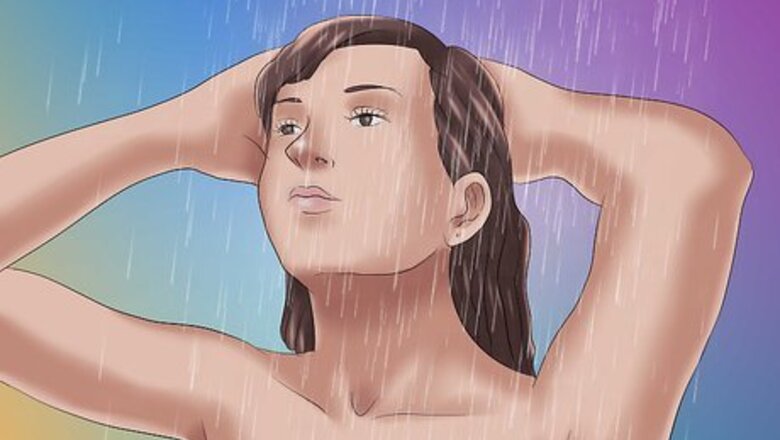
views
Creating Your Base Braids
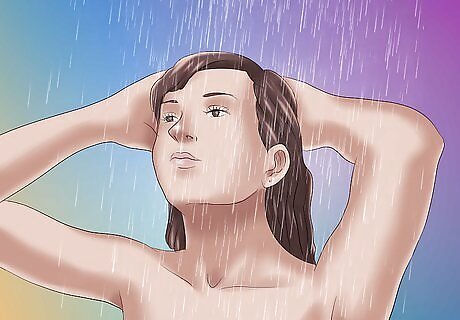
Wash and condition your hair. You should always prepare your hair for cornrows/weave prior to executing the style. Wash your hair as you normally do, and give it a good conditioning treatment as well. Make sure that your hair is totally dry before starting the cornrow process.
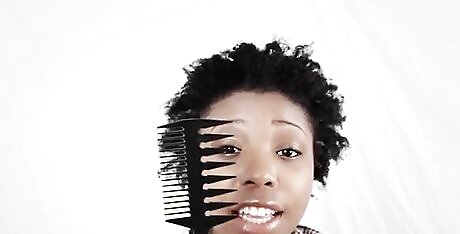
Gather the necessary supplies. To create the base to sew your weave onto, you have to braid your head in a series of cornrows. To do this, you’ll need a wide tooth comb, a fine tooth comb, and a hair pick. You will also need 2 to 3 large hair clips to hold your hair away from your face, and a detangling spray of some sort (3 parts water mixed with 1 part oil in a spray bottle works well).

Select your part. When you add your weave, you’ll place it in layers around a part in your natural hair. Your part is the exposed area of the scalp, and is typically located down the center of your head or slightly off-center. Choose the location of the part carefully because you will not be able to change it until you take out the weave. Separate out 0.5 in (1.3 cm) sections of hair on either side of it. Pin the rest of your hair back using the clips. Your part only needs to go about halfway back on your head.
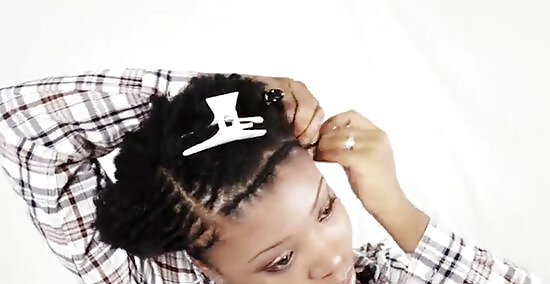
Braid the perimeter row. The first braid you will complete is a small braid that wraps around the outer edge of your face, head, and to the nape of your neck. The perimeter braid will have 2 starts - on either side of the part - but you will combine the ends of the braids together at the nape of your neck. Take your hair out of the hair clips, and section off a strand of hair 0.25 to 0.5 in (0.64 to 1.27 cm) thick all the way around the outer edge of your head. Starting with the edge-braid from your part, braid as far as you can around the edge of your head. Then, do the same on the other side. You might combine the perimeter braids off to the side rather than directly in the center on the nape of your neck, if your part is off-center. Keep the braid as tight as you can, and as close to your scalp as you’re able.
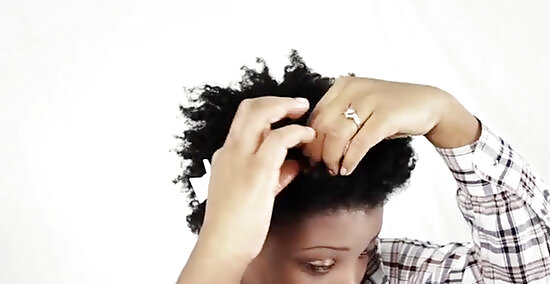
Begin braiding your part. To show your part, you will braid two rows of hair on either side of the part, away from each other. Start with one of the 0.5 in (1.3 cm) sections of hair, and separate a small piece about 0.25 in (0.64 cm) thick on one of the ends. Braid this in a French braid towards the back of your head on the one side of the part. Braid this strand about ⅔ of the way down, leaving the ends loose (they will be incorporated into a larger braid later on).
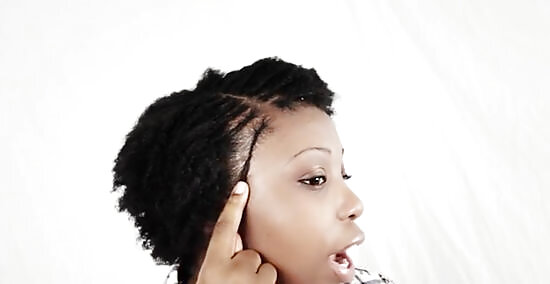
Finish braiding your part. Work down both sides of the part, braiding small French braids 0.25 in (0.64 cm) wide. Remember that the braids should run parallel to your part and you should work down your head in horizontal sections. Because you won’t be able to French braid each strand all the way, the ends should be loose after you’ve braided all the hair near the scalp. Each of the strands that are loose will be the start of a row of braids going all the way around your head.
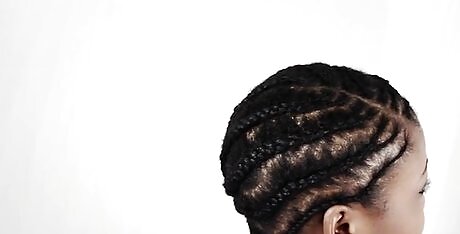
Begin the center braids. Each of the braids you began on either side of your part will continue on to form full braids that wrap around your head. This means that from a birds-eye-view of your completed head, there will be concentric circles formed around your part. Follow the pattern of the perimeter braid, by sectioning off thin pieces of hair around the outer edge and working in. Go to the next braid closest to your hairline, and braid on either side of your part towards the back of your head. Continue spraying your hair with the oil/water mixture or your detangler spray to make braiding easier. Your braids should be very tight and may hurt while braiding, but shouldn’t be painful when completed. The braids will likely become quite thick about halfway through, because of all the hair you gather. Don’t be worried if because of this your braids are uneven.

Finish your braids. Work inwards on your braids, away from your part. Each of the small braids you started on either side of your part should serve as the start for each new braid. If you run out of part-braids though, you can create more near the part on the back of your head. Tie off all the ends and tuck them into/under the finished braids so as to hide the tails.
Sewing on Your Wig Cap
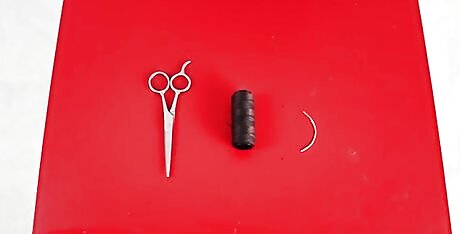
Get all of your supplies. For your weave, you’ll at need at least two packages of wefts of human hair in a color coordinating your natural hue. You’ll also need curved sewing needles, weave thread that matches the hair color, a wig cap, and a pick or fine tooth comb for separating sections of hair. When you finish weaving in a weft of hair, you’ll cut the excess with a pair of shears, so have those on hand as well.
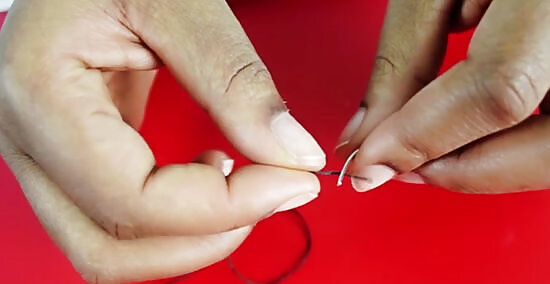
Prepare your needle and thread. Get your special weave-thread out, and cut a piece that is 2–3 feet (0.6–0.9 m) long. Thread one end of the string through your needle, and pull it so that both ends are even. Then, wrap the ends of the thread around the tip of your finger, and tie them together in a knot. This will form a loop on which your needle is strung. Cut the excess thread off that is left over from tying your knot; try to cut it as close to the knot as you are able, so as to make it as discreet as possible when woven into your hair. Don’t cut too much thread to start, as the longer your thread, the more tangles and knots that are likely to be formed. You’ll probably run out of thread often, so you’ll have to repeat the aforementioned process each time that happens.

Put on your wig cap. Pull your wig cap out and stretch it out, sliding it over your head. Cover your entire hairline all the way around; the wig cap should go over your ears, forehead, and the nape of your neck as bit so as to make sure your braids are completely covered.

Begin sewing your wig cap to your braids. Start at the beginning of your perimeter braid near the part, and pull the needle under the braid and through the other side, pulling the thread taut against the knot. Then, pull the end of the knot out just a bit and pull the two strings apart to expose the loop. Wrap the needle around one edge of the loop twice, and pull it through the center of the loop to create the base knot.
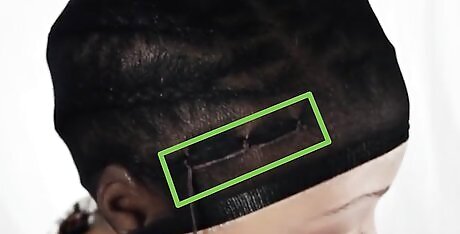
Sew the wig cap to the perimeter braid. Measure about 1-inch down the perimeter braid from the first knot you made, and repeat the process. Hook the needle under the braid, pull it through the other side, and tug to pull the loose thread tight. Before the thread between the two knots has been tightened all the way though, wrap the needle around it twice near where you inserted it, and pull tight. This will give you your second knot. Repeat this same process all the way around the perimeter braid. Each knot should be about 1 inch (2.5 cm) apart from each other. Make sure that your knots and thread are pulled tight, so that your cap is firmly attached to your braids.
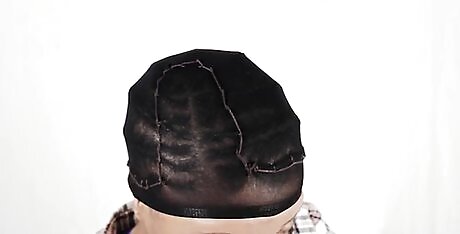
Sew the wig cap around your part. When you’ve sewn the wig cap around the perimeter braid, you’ll complete the ‘loop’ by sewing around the outside of your part. Starting from your last knot on the perimeter braid, skip up to the next row of braids on your head. Repeat the knot-tying process, and then go up to the next row. By the time you’ve sewn around the part, you should have a large ‘U’ shape of knots. Make sure that each knot is at least 1-inch away from the center part. Finish off by tying two knots at the base of your sewing, where you started on the perimeter braid. The finishing knots should be the same as the other knots you’ve been sewing the whole time. Cut the extra string off as close to the knot as you are able, without cutting the knot.
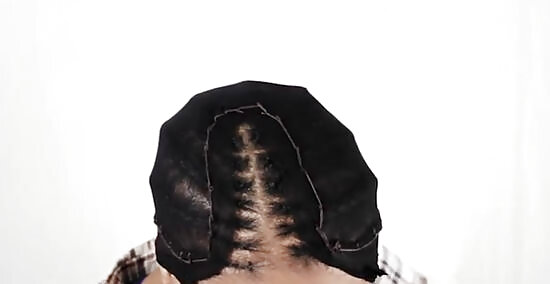
Cut off the excess wig cap. Take your shears and cut up along your part to split the wig cap. You’ll be removing all the excess fabric around the edge of your sewing (the part that went over your forehead, ears, nape of your neck, and the covers your part). Once you’ve cut up your part, cut all the extra fabric off as close to the edge of your thread as possible, without getting close enough to cut the knots. If you accidentally cut the thread or a knot, you’ll have to remove what work you’ve done and start over with a new wig cap.
Sewing on Your Extensions
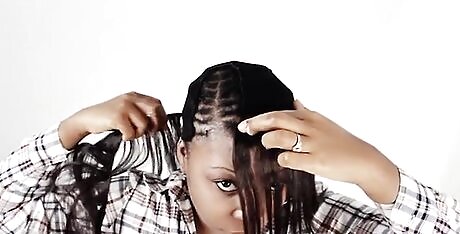
Measure your extension-hair for the perimeter braid. The first extension that you will measure and apply is the piece that goes around the perimeter. Take your extensions out of the package, and open one weft so that all the hair is exposed. Starting at the beginning of your perimeter braid, hold the extension in place, and wrap it around your head. Hold it to the perimeter braid the entire time to make sure it is the right length. When you get to the end of the perimeter braid on the other side, measure a little extra hair, and then trim it to fit. Place this piece of perimeter-extension off to the side, so that you don’t misplace it or confuse it for another section of hair.
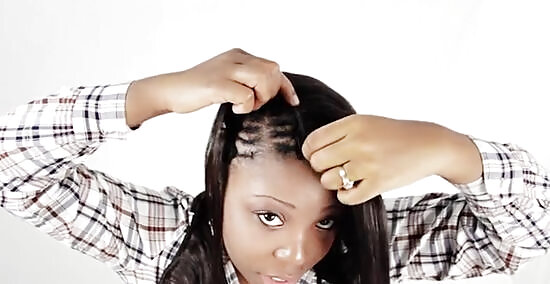
Measure the extension to go around the outside of your part. The second major section of hair you need to measure is the piece that will go around the ‘U’ shape of your part. Hold the end of the extension over the beginning of the ‘U’ shaped part near your forehead, and wrap it around where you have already knotted. When you get to the end on the other side (back to your forehead), add a little extra length to your measurement, and then cut the piece of extension. Keep track of this extension, and make sure you don’t confuse it with the perimeter extension.
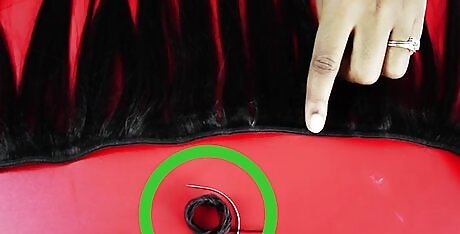
Prepare your thread. You’re going to be working with a long strip of extension, but you won’t be able to use all the necessary thread in a single shot. Cut a piece of your weave thread that is 5–6 feet (1.5–1.8 m) long, and use the same process as you did for your wig cap by threading it through the needle, matching the ends, and tying them together in a knot. Cut off any excess string.
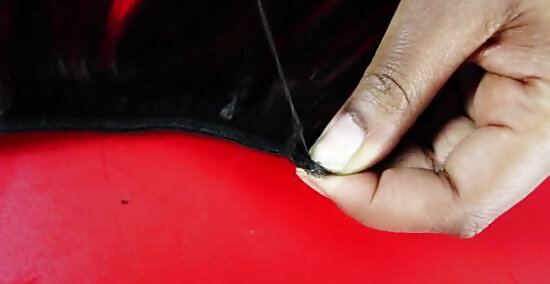
Create your base knot through the weft of the extension. Every time you section out a new piece of extension to sew on, you’ll have to create a knot to secure it. The extension is made up of two primary parts: the strands of hair, and the weft which holds them together. Stick your needle through the weft at the very beginning of the extension to secure it. To tie your first knot, you’ll wrap the needle around, pull it through the weft a second time, wrap the loop that is formed around the needle twice, and pull the needle through. The knotting process involved is the same as you used to sew your wig cap to your cornrows. You should have plenty of excess thread when you’re finished tying your not; don’t cut this, as you will be using it to weave your extension to your head.
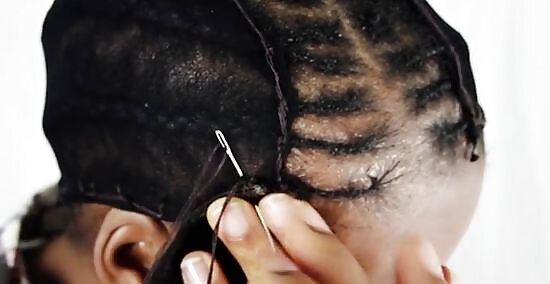
Begin sewing the extension to your wig cap. Start at the very beginning of your perimeter braid near your part, and insert the needle through the wig cap, under the perimeter braid, and up through the other side. Pull it tight to bring your extension piece close to your head. Then, make your first knot by wrapping the needle/thread around the weft (not through it) and repeating the same knotting process as you used for sewing your cap. Repeat your knot twice to secure the extension. You’ll only double-knot the extension at the very beginning.

Continue sewing your perimeter extension. Using the exact same process as you did to sew on the wig cap, work around your head sewing on the extensions that attach to the perimeter braid. Make each knot about 1-inch apart, and hold the extensions taut so that they are securely attached to your head. Do this all the way around your perimeter braid until you’ve made it to the very end, on the opposite side of your part. Be careful not to tie strands of hair into the knot. Trim off any excess that you might have once you have completed sewing on the perimeter extension.
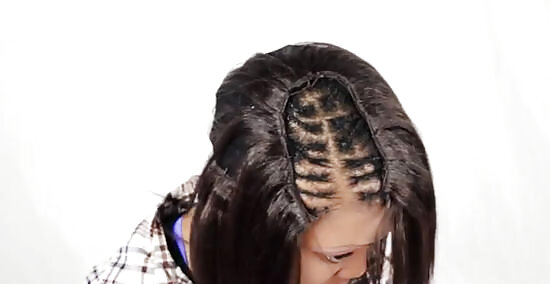
Sew your extension around the outside of your part. To finish off the ‘border’ of your hair, you’ll have to sew your extension piece around the edge of the ‘U’ shape that your wig cap forms around your part. Start by preparing a new piece of thread and attaching it to the end of the weft. Then use the exact same process as explained above to sew the extension to the braids/wig cap around your part. Trim off any extra that you might have at the end.
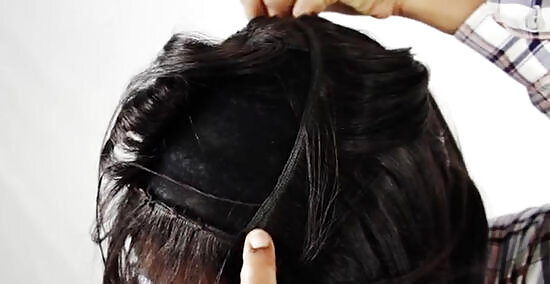
Begin filling in the rest of your head with the extensions. Starting at the second row of braids (the second to the perimeter braids) you should begin filling in the space on your head with the rest of your extensions. Continue the same process as above, except that when you get to the end of your row (on the opposite side of the perimeter braid), you should use the ‘fold over’ method to begin an additional row. This means that instead of cutting off the excess extension when you reach the end of a row, you fold it back on itself and begin sewing the new row directly above it. Always sew a knot directly over a fold when you fold over a section, in order to make it lay flat. It is helpful to do this twice, to make sure it is 100% secure. Don’t measure and cut your pieces prior to sewing additional rows, because the fold-over method will make it easier to continue working with the same weft for a large portion of your head.
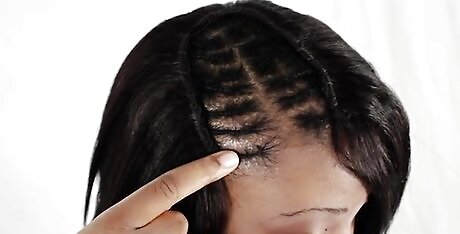
Finish filling in your head. Work around your head, using the exact same process of sewing your weave to your cap/braids as you have been. Remember to always double knot over a fold or the beginning of a weft, to properly secure it. When you have finished filling in your head, trim off any excess that might hang over the front.

Sew on your closure for your part. If you’ve done all of your sewing correctly so far, you should be left with about 1-inch of exposed braids all the way around your part. Sewing your weave onto this section is similar to when you originally braided it, as you will be working with small sections away from the part. Measure the exposed braid, and cut off the same amount of your weave. Sew each small section (about 1-inch wide) onto the exposed braid. This means that you will have many small pieces to sew, and each should run somewhat parallel to your forehead. Use the exact same process, making sure to double-knot both the beginning and end of each thread. It might be helpful to have several needles with thread prepared before starting this, because you’ll be working with so many small pieces of weave which may be difficult to do with a single long piece of thread. As the layers build, your part should look more and more natural, and the weft of each piece of extension should begin to be covered up.
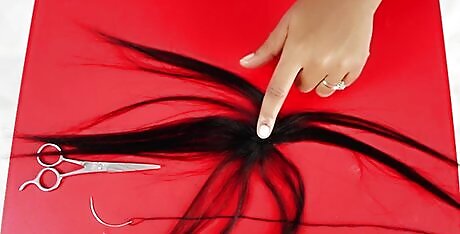
Create your closure for the back of your part. When you’ve sewn on extensions to all the small braids along your part, you should be left with a space in the back that is still open. To fill this in, you’ll have to prepare a special piece of your weave. Measure the space that you have to fill, and cut a piece of your weave that is twice that length. Start with your regular double knot at the end, and then roll the weave in to create a small circle. Create an additional knot by looping around the two layered sections of weft, and pulling it tight. Continue rolling and knotting the extension until you have finished the whole piece. When you tie the last knot, pull the needle through all of the layered wefts to secure them together. Cut the excess string off when you’re finished tying it.
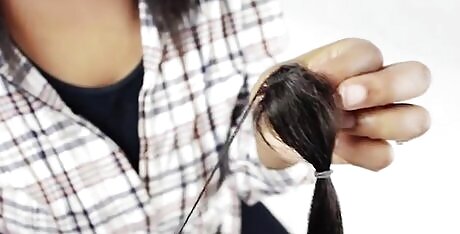
Adjust your closure piece. Turn your closure piece upside down so that the weft is facing the ground, and the hair is upwards. Begin flattening the hair so that it falls down over the top of the rolled up weft. Because of the roll that you created, the hair should fall evenly around it, hiding the weft and your sewing. It may be helpful to use a flat iron on the hair to get it to cooperate with what you’re trying to get it to do. Secure the ends of the hair with a small elastic to making sewing it to your scalp much easier.
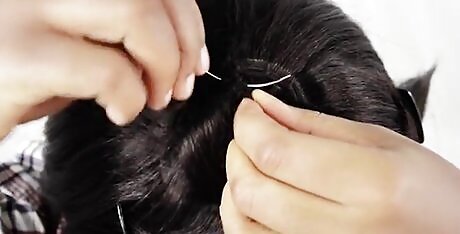
Sew your closure to your head. Turn your closure piece back over so that the weft is exposed, and insert your needle and thread through it to tie your regular double knot. Bring your closure to your scalp, and place it where you want it to go. Insert your needle through a braid or a piece of weft from another extension nearby on your scalp, and pull it tight to create your regular knot. Continue doing this in a circular movement around your closure piece, until you’ve gotten back to the beginning. Cut off the excess string, remove the elastic from your hair, and you’re done! Adjust the strands of your closure piece to cover up any weft that may be visible.
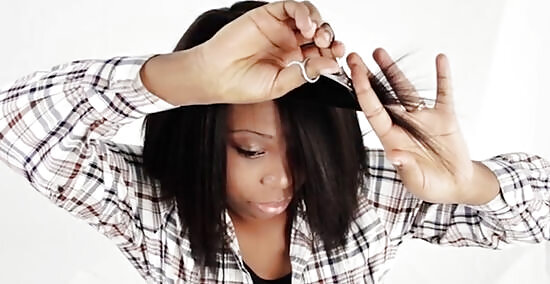
Cut and style your weave. Attaching your weave to your head is now completed, so you have the option of cutting and styling it to your personal preference. Keep in mind that your cut is permanent since your hair isn’t going to grow in, so be very careful about cutting your hair. Maintain your weave regularly, but avoid washing it too often as this may loosen up the ties and your wig cap. Point cutting your ends is a great way to reduce bulk and get some texture into the ends of your weave. Hold the scissors perpendicular to the ends of your hair and make some 0.5 in (1.3 cm) cuts into the ends.















Comments
0 comment